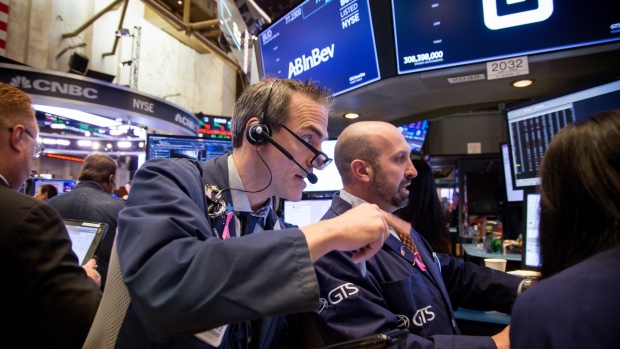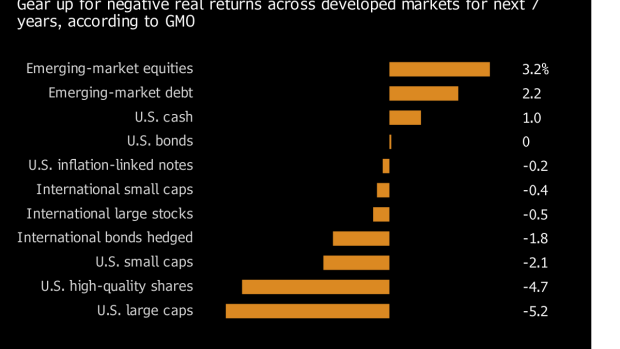Nov 23, 2018
A brutal global market in 2018 has just one champion
, Bloomberg News

Gather a basket of the world’s biggest assets. Strip out the volatility. Calculate the returns. Then find a nice corner where you can weep, and wish you’d put everything in T-bills.
After another bruising week as portfolios sank deeper into the red, there may be no escaping it: Almost everything is going to lose this year.
By one simple measure, this is the worst cross-asset performance in more than a century.
With about US$3 trillion of U.S. stock value wiped out since the September peak, investors mapping strategies for 2019 are facing a gut check as a topsy-turvy market defies conventional wisdom. Above-trend growth, tax cuts, record stock buybacks and stellar corporate earnings were supposed to power the bull market anew. What hope now for the business and market cycle?
“That’s the market making a pretty big call on what’s about to come -- the cycle is winding itself down finally, after nine years of recovery,” said Rich Weiss, chief investment officer and senior portfolio manager of multi-asset strategies at American Century Investments. “There is nowhere in the rest of world that you can look to for help.”

Volatility Bites
Amid the debris of 2018 may be some lessons of survival for the year ahead, not least the role of volatility.
The spread between the best and worst performers this year among 23 major asset classes selected by Bloomberg is the narrowest since the financial crisis, based on absolute returns. Put simply, everything is struggling together.
But an interesting thing happens when you adjust for volatility -- that is, compare the relative performance of stocks and bonds and commodities after accounting for how much each one bounced around. Doing this, something that rises 20 per cent in a year by going up or down 5 per cent a day compares unfavorably to something that rises 10 per cent via a steady succession of tiny gains.
Viewed this way, the gap among asset returns becomes the widest over that period -- stripping out the year’s stomach-turning volatility neutralizes everything and makes the quiet advance in Treasury bills all the more precious. In 2018, escaping price swings has been your ticket to outperformance.
And here U.S. Treasury bills lived up to their reputation as the safest, most even-keeled asset of all, earning risk-adjusted returns of almost 20 per cent -- more than double the nearest rival, leveraged loans. They are the undisputed winners of 2018.
The global sell-off has other silver linings. It’s bringing valuations back down to earth, and may wind up restoring some discipline to the equity and credit market.
“This volatility either will act to deflate excesses and extend the cycle or pull forward a downturn,” said Geof Marshall, who oversees $40 billion of assets at CI Investments’ Signature Global Asset Management in Toronto.
King Dollar
Wall Street’s America-First playbook may be struggling in stocks and credit but it’s working for dollar bulls, with the currency topping the pile in absolute terms. But for those assuming the tumultuous year for overseas assets is just a strong-greenback story, think again.
As of mid-November, the tally of assets losing in local-currency terms was 66 per cent, or 46 out of 70 markets, according to Deutsche Bank. That’s the third-worst showing since 1901. And the dollar’s 4.7 per cent return, if it holds, would make it the weakest top performer since at least the crisis -- underscoring just how lackluster 2018 has been overall.
At the other end of Bloomberg’s performance table, stocks across emerging markets and the Asia-Pacific region as well as oil are the biggest disappointments in 2018 in absolute terms. But their losses -- in the region of 10 per cent -- look in line with recent years.
Developing-nation assets may turn a corner soon enough. GMO LLC, a value investor with US$70 billion, foresees negative returns across most asset classes adjusted for inflation for the next seven years, with emerging-market assets alongside cash offering the only source of gains.
There are crumbs of comfort in this year’s ruins. The average return for the set of 23 major assets tracked by Bloomberg, both in absolute and risk-adjusted terms, is only the worst since 2015 on an equal-weighted basis. Back then heavy losses in commodities, the dollar and euro conspired for an even uglier 12 months.
And crypto investors have had it much worse: the value of digital tokens is down by almost US$700 billion since the January peak, or about 80 per cent.
In sum, after basking in synchronized growth, monetary stimulus and vanquished volatility in 2017, investors are getting a lesson in the violent nature of market swings -- and it’s raising existential questions about the link between the business and market cycle.
“Are we now in a regime where developed-market growth can be above trend but with asset prices facing more headwinds and with higher volatility than they were when growth was weaker?” asked Deutsche Bank credit strategists led by Jim Reid.
--With assistance from Cecile Gutscher, Natasha Doff, Lu Wang and Srinivasan Sivabalan.









